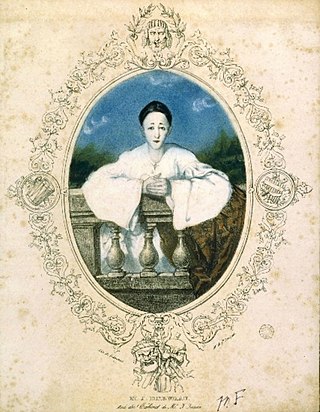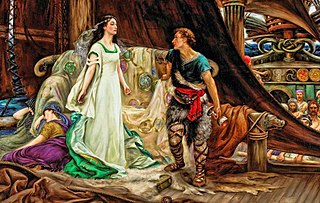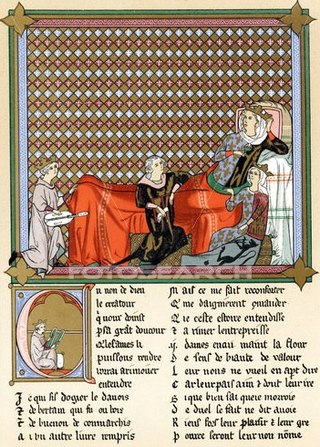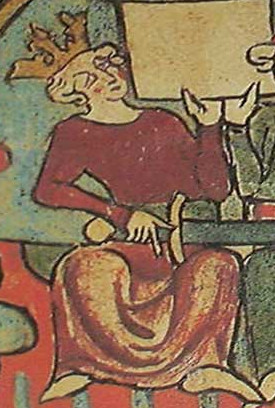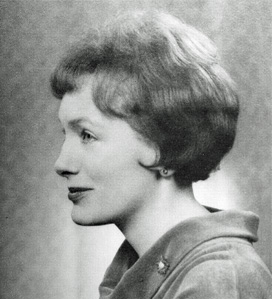Attestations
The tradition that Ogier had a short sword is quite old. There is an entry for "Oggero spata curta" ("Ogier of the short sword") in the Nota Emilianense (c. 1065–1075), [2] and this is taken as a nickname derived from his sword-name Cortain. [3] The sword name does not appear in the oldest extant copy of The Song of Roland (Oxford manuscript), only in versions postdating the Nota. [4] [lower-alpha 1]
The sword and its early provenance is described in the chanson de geste Le Chevalerie Ogier. [6] [7] The sword has appeared in other chansons de geste somewhat predating Chevalerie Ogier, or composed around the same time as it, such as Aspremont (before 1190) and Renaut de Montauban (aka Quatre fils Aymon , c. 1200). [8]
Provenance
Generally according to traditional French sources, Cortain was previously owned by the courteous Saracen knight Karaheut, and given to Ogier. [9] [11]
According to the first branch (enfances) of Le Chevalerie Ogier, Ogier was still unknighted and sent as hostage to King Charlemagne. Thus when the French began to fight Saracens invading Rome, the unarmed Ogier only spectated. Eventually however he entered the fray, wresting the arms of the standard-bearer Alori who fled in retreat. [12] [13] His deeds were rewarded by knighthood, and Charlemagne girt him with his own sword. [14] [15]
In the continued conflict, the Saracen Karaheut of India [lower-alpha 2] [lower-alpha 3] who owned Cortain challenged Ogier to duel. Karaheut's weapon, "the sword Brumadant the Savage" [22] [lower-alpha 4] was remade more than twenty times by the swordsmith Escurable; when it was tested on a block of marble it broke about a palm's length, and had to be reforged shorter-bladed; hence it was [re]named Corte or Cortain, [29] meaning "Short". [6] [7] This became the weapon of a chivalric-minded Karaheut, [30] who gave his destrier and arms (including Cortain) to Ogier so he could now fight the new opponent, Brunamont, in single combat. [lower-alpha 5] [lower-alpha 6] [35] [36] [37]
Renaud de Montauban
Ogier tested the sword on a perron (stone block [lower-alpha 7] ) and the sword got chipped (a "half a foot"; Old French : demi pié" [40] [42] ), giving rise to the name "Cortain (Short)", or so it has been told in the poem Renaud de Montauban (aka Quatre Fils Aymon ). [43] [44] [lower-alpha 8]
Saga I version
According to the Old Norse version Karlamagnús saga Part I (c. 1240 [45] ), Karlamagnús (Charlemagne) tested three swords at Aix-la-Chapelle, and the first that only made a notch in the steel mound or block [lower-alpha 9] received the name "Kurt" (Cortain), the second that cut a hand-width "Almacia ", and the third chopped off a chunk more than a half a foot" (possibly 1/2 foot measure (6 in (150 mm)), or "half leng-lenth"), earning the name Dyrumdali". [51] [lower-alpha 10] [53] Thus this Scandinavian account fails to explain how the sword got its name, unlike the French text which reveals that the sword was curtailed when tested. [54] The meaning of "Kurt" in Old Norse would be "courtesy" or "chivalry". [55]
All three swords were received as ransom from a Jew [58] named "Malakin of Ivin", and all made by Galant of England, [59] namely Wayland the Smith, [60] not the sword-maker named in Chevalerie. [39]
Blocked by angel

Ogier turned rebel (after Prince Charlot murders his son Bauduin/Baldwinet over chess [63] [64] ), and eventually was made prisoner in later branches of Le Chevalerie Ogier. In the ninth branch, he was offered reprieve in exchange for cooperating with fighting a new wave of Saracens, but refused unless he could exact vengeance against Charlot. [65] [66] Ogier was about to strike Courtain upon Charlot, when the archangel Michael interceded, holding the sword by its blade or edge, [67] and staying the execution. [68] [69]
Post-13th century
The sword recurs in the later poems in the decasyllabic (c. 1310 [70] ) and Alexandrine (c. 1335 [71] ) versions, and the 15th century [72] prose romance of Ogier, e.g., the scenes of Karaheu (Caraheu) using it in single combat with Ogier. [73] The prose redactor retained the episode of an angel (though he was an anonymous "ung ange de paradis", not specifically St. Michael) who "holds back the stroke of Ogier's sword and took the sword by the point (retint le coup de l'espee d'Ogier et print l'espee par la pointe)" to stop Ogier from killing Charlot with the sword Courtain. [74] Later printed editions have further altered this to stating (in chapter summary) that the angel held back Ogier's arm. [75]

Various accounts of the sword, Kortone, are also given in the Danish Olger Danskes krønike (1534), adapted from the French prose. The work notes that the sword could still be viewed at the "cloister of St. Bent (=Benedict [76] )'s order" at Meaux (near Paris) in France. [77] [78] It also records the episode of Olger's sword Kortone being stopped by the angel (see fig. right). [79]
Arthurian cycle
The Prose Tristan (1230–1235, expanded in 1240 [80] ) also names Ogier as eventual owner of the sword, though claiming it to have been a relic of the Arthurian knight Tristan (Tristram). Since the sword was originally too long and too heavy, Ogier shortened it and named it Cortaine. [lower-alpha 11] [81] [82] [83] According to this French narrative, Charlemagne brought discovered the swords of Tristan and Palamedes in an abbey in England, giving the Tristan sword to Ogier, and girt Palamedes' sword on himself, which was judged to be a superior sword. [81]
In the La Tavola Ritonda (mid-14th to 15th century) based largely on the Italian translation of the Prose Tristan, Tristan's sword is named Vistamara, considered the best and sharpest in the world. [84] [85] In this version Charlemagne (Carlo Magno) comes to Verzeppe Castle (presumably Leverzep/Louvezerp) in Logres [87] and finds the statues of five eminent Arthurian knights, each wearing their original sword. [88] Tristan's sword was given to Ogier (Ugieri) who was the only one capable of wielding the heavy sword, but the sword was clipped short upon its first use, and so was named Cortana. [89] [82]
The English monarchy also laid claim to owning "Tristram's sword", [lower-alpha 12] and this according to Roger Sherman Loomis was the "Curtana" ("short") used in the coronation of the British monarch. Loomis also argues that Curtana's origins as Tristram's sword was known to the author of this passage in Prose Tristan, but the tradition was forgotten in England. [83] The English royal Curtana had been once been jagged at its broken tip, and in the Tristan/Tristram romances, the hero's sword broke off, with its tip lodged in Morholt's head. [90]




